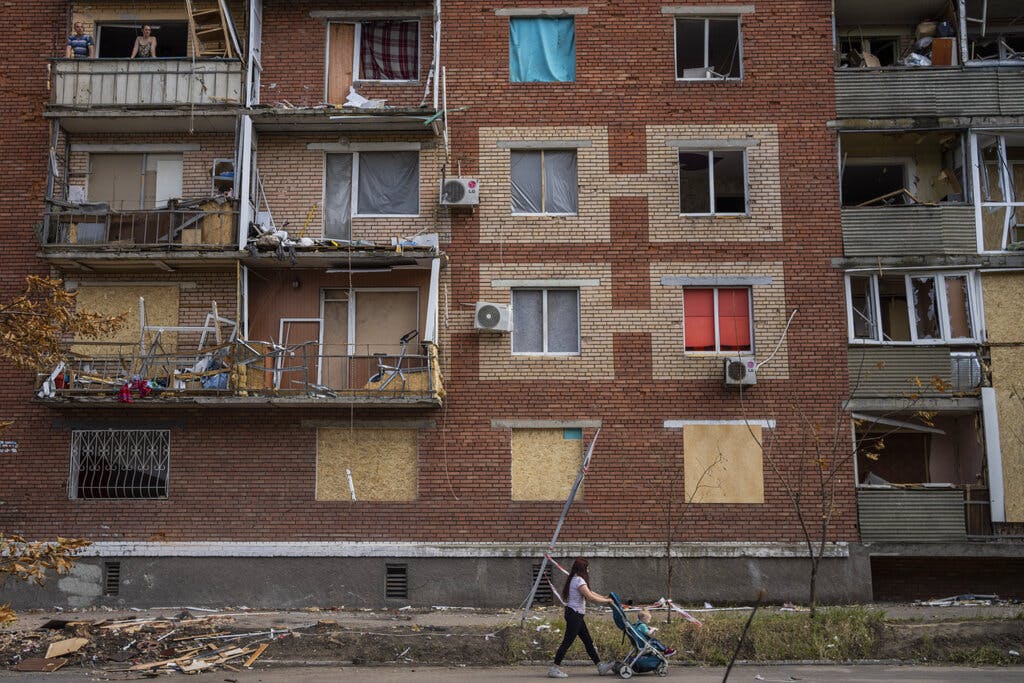‘Turn Off Your Cell Phones,’ Captain Sasha Orders — And Welcome to the Pro-Russian Side of the Front
Today it seems impossible to predict how much territory will be ceded to Russia, but equally impossible to imagine the east of Ukraine will return to Kyiv’s control.

“Turn off your cell phones, otherwise Ukrainians can locate us.” The order comes from Captain Sasha, who sits in an armored military vehicle of the Lugansk People’s Militia, the pro-Russian soldiers fighting alongside the regular Russian army in the Donbas region, eastern Ukraine.
Russians have been here for eight years and since February 24 they have advanced westward along with their local allies. Sasha sits next to some militiamen with hidden faces, holding kalashnikovs in their hands. A big letter Z, a symbol of the Russian aggression that is thought to stand for “victory,” can be seen on one sleeve of each military uniform.
The car proceeds at full speed down a dirt road in the middle of the steppe toward Rubeizhne, a city previously under Ukrainian control that Russians conquered a few hours before. Heavy fighting is still raging around it.
Rockets of retreating Ukrainians, who are trying to bomb the road to slow the Russian advance, rain down on the fields around us. Beside the road lie dozens of wrecked wagon carcasses, some still burning.
Long lines of tanks waving Russian and red flags advance in front of us. Behind us follows a van coming from Moscow and loaded with packages of humanitarian aid destined for the population trapped at Rubiezhne.
The city has been partially destroyed by shelling. High, gray, Soviet-style buildings have been demolished, streets are covered with rubble, and nobody but Russian soldiers can be seen. The silence is interrupted by the loud bangs of bomb explosions from the adjacent areas, where a handful of Ukrainian soldiers still oppose the Russian advance.
Many small wooden crosses are planted in the ground in front of the houses. These are the makeshift graves of civilians who died under the bombs, buried hastily by relatives or neighbors both for dignity as well as hygiene. With the arrival of the spring temperatures, the corpses were decomposing.
Our car and the humanitarian aid van stop at a school, which now serves as a refuge for civilians. Fifteen or so exhausted people emerge. Men and women, elderly and children. Their faces are pale and thin, hollowed out by hunger, their hair greasy due to the absence of water, their expressions bewildered after living underground for months.
Quickly, they line up in front of the van to take packages of humanitarian aid. The colors of the Russian flag can be seen on each. As each individual grabs his or her package, they duck quickly back into the building, while explosions thunder in the background.
Entering the school, we meet the administrator of this refuge, Natalia. She speaks to us in Russian, her mother tongue, though she has a Ukrainian passport: “We have been living here hidden for months. We have no water, gas, electricity, and very little food. Our survival depends on the aid the Russians give us.”
Then she leads us into the basement. Passing through dark corridors, we reach a large bunker where about 150 people have been living together for months. Only a few candles break through the darkness where dozens of exhausted people lie side by side on improvised pallets.
“My house was bombed,” Irina, 82, cries. “I have nothing left but the blanket I’m wrapped in.” Natalia hands her a package just brought by the Russians. It contains medical supplies, soap, and hygiene products. Such products are the only way to survive for many desperate people who remain.
As the Russians advance in eastern Ukraine, they are also laying the groundwork for their longstanding presence in the region. They don’t want to just defeat the Ukrainian army, they want to win the hearts and minds of the local russophone population. Hence, the aid the Russian army and pro-Russian militias bring to villages and cities they have just bombed.
Scenes similar to Rubiezhne are seen everywhere in the Donbas — in Volovakha, Severodonetzk, and Mariupol. As soon as they arrive, the Russians distribute humanitarian aid, introduce their own currency, and allow citizens to register for aid programs that will allow them to receive pensions and subsidies from Moscow within weeks to replace those previously provided by the Ukrainian government. The next step is for Russian entrepreneurs to arrive in the area to offer business opportunities.
The Kremlin is also exporting its ideology in Ukraine. Much of the humanitarian aid provided by Moscow is distributed by United Russia, Vladimir Putin’s hegemonic party. In addition to aid distribution, his party is also involved in “spreading our ideology among our Russian compatriots who have so far lived under Ukraine,” a young spokesperson for the party, Elena, says. Activists arrive in conquered towns and villages to distribute gadgets, books, and flyers, all in Russian.
“We are inspired by the idea of Russkiy Mir [the Russian world]; that it is the duty of every Russian to take care of each of his compatriots in need, even if he lives in another state.” The population of eastern Ukraine is largely Russian speaking, as well as steeped in Russian culture, realities Moscow’s activists are trying to build upon in order to enhance the common ethnic, linguistic, historical, and religious background needed to achieve permanent co-existence between its army and the local population.
The Kremlin is clearly laying the foundation for a division of Ukraine and the annexation of part of the country to the Russian Federation. Currently, Mr. Putin is pushing to achieve a de facto annexation of eastern Ukraine, therefore of Donbas, and of southern Ukraine. The manu military conquest of these territories is now necessary to be able to sit down at future negotiating tables starting from a position of strength.
Leveraging the military successes, as well as the linguistic and cultural proximity to Russia of part of the Ukrainian population may give Mr. Putin the ability to successfully argue that Kyiv should give him some territories in order to prevent a large-scale war breaking out between Russia and the West. Mr. Putin is well aware of the existence in the West, especially in the United States, of currents of thought that see the territorial partition of Ukraine as the only viable solution to resolve this conflict.
Secretary of State Kissinger, who served under Presidents Nixon and Ford, is a proponent of these views — and Mr. Putin is making the most of it. Today, it seems impossible to predict how many territories will be ceded to Russia, but it seems equally impossible that the east of Ukraine will ever return to Kyiv’s control.

